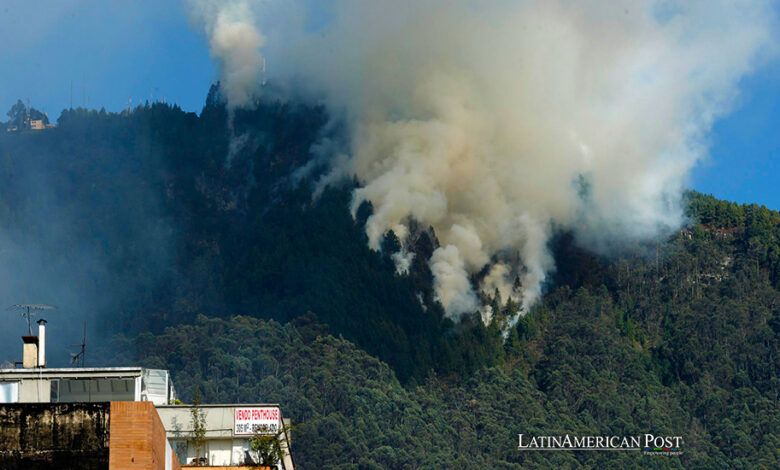Colombia in a Fiery Crisis as El Niño Ignites Widespread Wildfires

Colombia faces a devastating wildfire crisis fueled by the El Niño phenomenon, with numerous fires threatening cities and destroying iconic landscapes.
Unleashing El Niño’s Fury
The El Niño phenomenon has been lurking in the shadows in Colombia for months. Still, its most brutal face has recently emerged, with numerous wildfires intimidating the country’s major cities and ravaging hectares of Colombia’s most emblematic landscapes.
A dry spell coupled with record-high temperatures has created the perfect storm for igniting 21 active wildfires across the departments of Santander, Norte de Santander, Boyacá, Vichada, Antioquia, and Cesar. The parched conditions and scorching heat have rendered the vegetation highly combustible, setting the stage for an unprecedented ecological crisis.
In the paramo of Berlin, part of the Saturban paramo complex, a particularly concerning fire rages. This ecosystem, crucial for supplying potable water to northeast Colombia, has been devastated, with hundreds of fragile ones – unique plants vital for water regulation and spring nourishment – being consumed by flames.
Frailejones, known as natural water factories, grow at just one centimeter per year, making their loss particularly significant. According to Juan Carlos Reyes, director of the Regional Autonomous Corporation for the Bucaramanga Plateau, over 300 hectares of vegetation have been scorched in this area alone, including 40 hectares of frailejones.
Capital in Crisis: Bogota’s Battle
Even Colombia’s capital, Bogota, has yet to be spared. After tackling a fire in the eastern hills, another blaze broke out on Wednesday in El Cable Hill, with dozens of firefighters and helicopters attempting to extinguish it. Bogota’s mayor, Carlos Fernando Galan, reports at least four active fires in the city. At the same time, Medellin has also been a focal point for flames, with firefighters managing to control 10 fires.
The onset of El Niño was declared by Colombian authorities last November, prompting local and departmental officials to prepare for the impending consequences of fires and droughts. El Niño, a climatic phenomenon triggered by a rise in Pacific Ocean temperatures, causes uneven rainfall distribution in Colombia, resulting in some areas experiencing downpours while others face severe dry spells.
Even without El Niño, this year would have been a dry season. Still, the presence of the phenomenon has exacerbated conditions. Johana Herrera, Forests and Climate Change Officer at WWF Colombia told EFE that the abundance of dry vegetation has significantly increased the risk of fires.
Contributing to the crisis, temperatures in at least nine parts of the country soared to record highs on Tuesday, with the mercury hitting 40.4 degrees Celsius in Jerusalem, Cundinamarca, near Bogota, as per the Institute of Hydrology, Meteorology, and Environmental Studies (Ideam).
Ongoing Struggle and Potential Catastrophe
The severity of the situation led to a ministerial meeting chaired by President Gustavo Petro on Wednesday. The president announced plans to declare a “natural disaster” in response to the fires and droughts exacerbated by El Niño. “We have had more than 500 fires, and 60 municipalities are experiencing water stress. The warning about landslides on the Pacific coast remains,” the president said in a message on his X account. According to the Ministry of Environment and Sustainable Development, 179 fires have been extinguished in the first 24 days of the year alone.
Herrera highlights that the fires impact societal welfare, wildlife, and ecosystems with potentially devastating consequences. Experts anticipate that El Niño will end in Colombia by April. However, authorities warn that the worst could still be ahead, particularly in February, traditionally one of the driest months with the highest risk of forest fires.
Also read: Colombia’s Effort to Redefine Coca Plant Beyond Cocaine Stigma
As Colombia grapples with this ecological emergency, the world watches, reminded of the delicate balance between our environment and the climatic phenomena that can drastically alter it. The fires in Colombia are a stark reminder of the vulnerability of our ecosystems to climate change and the urgent need for global environmental stewardship.





